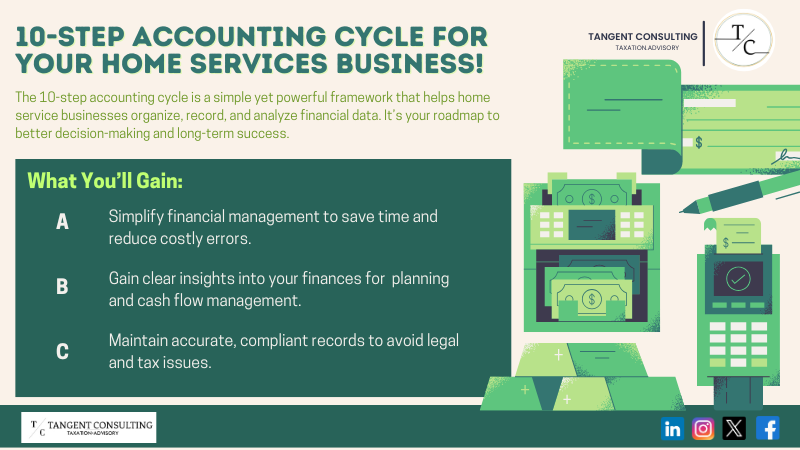10-step Accounting Cycle for Every Home Services Business
10-step Accounting Cycle for Every Home Services Business

Whenever the busy month ends (we are literally writing this at the end of the month, and boy, it has been busy), many small business owners find a mountain of invoices, receipts, and unanswered payment queries.
We get it. Accounting may not be the s*** part of running a business, but without a solid grasp of your financials, you won’t be able to scale your business.
So, let us introduce you to the 10-step accounting cycle—a straightforward process that can manage your financial chaos.

What You Need to know About the Accounting Cycle?
60% of small business owners admit they don’t have enough knowledge about accounting or finance. This often leads to costly mistakes, missed tax deadlines, or inaccurate financial reporting.
An accounting cycle can save the day for any business owner who lacks knowledge of accounting.
The accounting cycle is the structured process of recording, analyzing, and summarizing your business’s financial transactions over a specific period—usually a month or year. It’s sort of like a financial checklist that ensures nothing slips through the cracks.
Why is it important?
- It helps you see your revenue and expenses at any given time, ensuring there are no surprises at month’s end.
- Come tax time, you won’t have to scramble to find missing receipts or invoices because your financials are already in order.
- It gives you a clear picture of your finances, which helps you understand when to expand your services, hire, or invest in new equipment.

The 10-Step Accounting Cycle
In his iconic book, The E-Myth Revisited, Michael E. Gerber emphasizes a fundamental truth for small business owners: “If your business depends on you, you don’t own a business—you have a job. And it’s the worst job in the world because you’re working for a lunatic.”
Now, before you chuckle nervously, Gerber’s point is clear: your business becomes chaotic and overwhelming without proper systems in place. One system you can create is an accounting cycle.
So, let’s break down the 10-step accounting cycle:
1. Identify Your Transactions
Every journey begins with a first step, and in the accounting cycle, that first step is identifying your transactions. Transactions are the financial events in your business, such as receiving payments, purchasing supplies, or paying your employees.
Identifying these transactions is crucial because they form the foundation of your financial records. If you miss any transaction, it can throw your entire accounting process off balance.
So, the first step is to identify all your transactions.
Pro Tip: Use a dedicated bank account and credit card for your business. This makes tracking and identifying transactions easier without mixing them up with personal expenses.
If you are looking for a hands-free business bank account, we have partnered with Ramp to give you a $500 sign-up bonus. You can sign up here.

2. Gather Data for Journal Entry
Once you’ve identified your transactions, the next step is to gather the necessary data. If you are confused by gathering data, it means collecting every invoice, receipt, and payment record related to your business.
Imagine you’re reconciling payments for a landscaping job. If you don’t gather all the invoices related to the project—like fuel costs, plant purchases, and labor wages—you might end up thinking the job was more profitable than it was. That’s why gathering all data is important.
3. Record Transactions
Now that you’ve gathered all the data, it’s time to record those transactions in your journal. This step is where raw financial data transforms into organized records.
Recording transactions ensures every dollar earned or spent is accounted for. Skipping this step can lead to financial blind spots, making it impossible to understand overall financial operations.
Pro Tip: You can use accounting software like QuickBooks to record your transactions automatically.
4. Create a Trial Balance
After recording your transactions, it’s time to create a trial balance. A trial balance lists all your business’s accounts, including assets, liabilities, revenue, and expenses, and tallies the debits and credits.
The trial balance acts as a checkpoint before moving on to financial reports. If your debits and credits don’t match, it’s a sign that something’s off. Catching these errors can save you from a financial headache later.
5. Adjust Journal Entries
Creating a trial balance reveals areas that need fine-tuning, and that’s where adjusting journal entries comes in. This step ensures that your records reflect the true financial state of your business. It accounts for expenses or income that haven’t been recorded and corrects any inaccuracies.
Adjusting journal entries keeps your books accurate and compliant with accounting standards. Without these corrections, your financial statements might show a rosy picture that doesn’t align with reality.

6. Review Adjusted Balance
Once you’ve made your adjusting journal entries, it’s time to revisit your trial balance, which we updated earlier to reflect those changes. This step ensures your books are balanced, accurate, and ready for the next stage of the accounting cycle.
An adjusted trial balance confirms that all the tweaks and corrections were made correctly and that your accounts are prepared for financial reporting. Skipping this step can leave errors in your books, leading to inaccurate financial statements and potential tax issues.
7. Create Financial Statements
Now that you’ve adjusted and reviewed your balances, it’s time to create your financial statements. They include the income statement, balance sheet, and cash flow statement.
Financial statements show how much money you’re making, what you own versus owe, and where your cash is coming from and going.
Want to know if you can afford to invest in a new truck or hire an extra technician? These statements provide the answers. They’re also crucial for filing taxes, securing loans, or attracting investors.
If you are curious to learn more about financial statements, you can check our detailed guide here.

8. Close Your Books
It’s the end of the accounting period, and it’s time to close your books. This means that all invoices are accounted for, all expenses are logged, and nothing from the current period goes into the next one.
Pro Tip: It’s best to close your books every month rather than waiting till the year-end.
9. Review Post Closing Balance
Congratulations—you’ve closed your books! But hold on; there’s one final checkpoint left: review your post-closing balance. This step in the accounting cycle ensures that all temporary accounts, like revenue and expenses, are reset, leaving only your permanent accounts (assets, liabilities, and equity).
10. Record Reversing Entries
Finally, we’ve reached the last step. Reversing entries are optional adjustments made to simplify bookkeeping in the new cycle. It ensures temporary accruals from the previous period don’t complicate future transactions.
To illustrate reversing entries, let’s say you accrued $2,000 in wages for your crew at the end of December. When you pay those wages in January, the reversing entry ensures the expense is only recorded once in your books.
Final Thoughts
Accounting might not be as exciting as getting a big project, but it’s essential to any home services business. The 10-step accounting cycle isn’t just a checklist—it helps in scaling your business.
But wait! What if all this mumbo-jumbo is making your head spin, and you can’t seem to do it yourself?
Well, there’s a solution; you don’t have to do it alone. Partnering with professionals, like a fractional CFO or a specialized accounting firm, can take this burden off your back.
Tangent Consulting has years of experience working with landscaping businesses in bookkeeping, CFO services, tax preparation, and business consulting. You can check all our services here.
PS If you are reading this, it means you can have access to our free consultation for your landscaping business. Avail this for free today before we change our mind.
FAQs
Which accounts are not considered in a trial balance?
Temporary accounts like revenue, expenses, and dividends are excluded from a trial balance after closing.
How do you record a loss in accounting?
A loss is recorded by debiting a loss account and crediting the relevant asset or expense account, reducing equity or net income.
What does the balance sheet tell you about a company?
A balance sheet shows a company’s financial health, showing its assets, liabilities, and equity. It also reveals a company’s ability to cover debts and fund operations.
